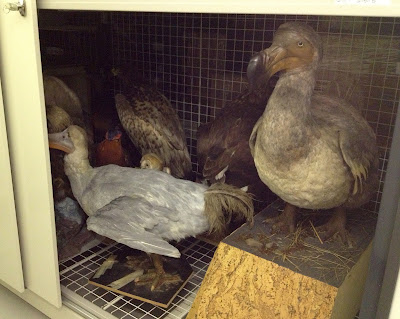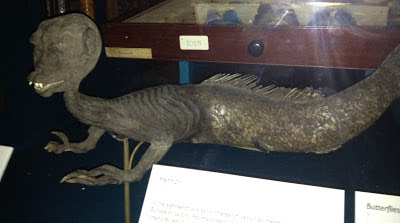Taxidermy
collections have always been a little creepy in my opinion and although I
understand their rationale for existence in museums, I’m not a big fan.
Taxidermy, as the art of preparing and mounting animals for display, has long
been a part of a museum history of learning. I can understand their existence
from an 18th or 19th century perspective where one might
not have ever been able to encounter these animals in far away locations, and
that today taxidermied animals are useful as study tools, again for
those who would not be able to see these animals in real life.
 |
| Red panda |
When I
went to work at the Great North Museum: Hancock, I was first struck by the fact
that the entire entrance is a greeting of multi-tiered mounted animals from
around the world.
I was then
later taken to the stores only to see that there were thousands of natural
history specimens such as trophy heads and 200 years of taxidermy. Some of the
collections of taxidermied animals are from the original collections of the
Natural History Society of Northumbria, which were created by John Hancock
(after whom the museum was originally named). Hancock was considered the father
of modern taxidermy, and his collections are considered an important part of
the history of the Great North Museum: Hancock (as it was renamed after 2009).
 |
| Bird in its 'habitat' |
Some
animals that people had never seen were very popular attractions in the museum,
such as the dodo bird. In the stores, there is an example of a mounted 19th
century animal in comparison to its 20th century counterpart, which displays
that modern thinking about the birds changed, and biologists thought them to be
more slim and streamlined in later years.
 |
| 19thC dodo on right, 20thC dodo on left |
In my
brief explorations of the taxidermy stores, I’ve come across some really
‘interesting’ examples of taxidermy/ taxidermy gone wrong!
 |
| Creepy fawn |
 |
| Shocked lioness |
But
nothing has been as interesting as the rogue taxidermy (the construction of
mythical or hybrid animals) creation of the merman at the Horniman Museum. This
is still one of my favorite museum objects to date! http://www.horniman.ac.uk/collections/unmasking-the-mysterious-merman
 |
| Merman! |




No comments:
Post a Comment